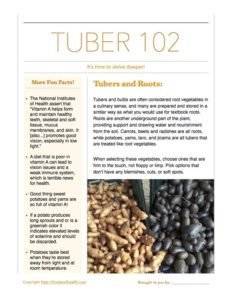Tuber 102: The Facts Continue
The fun continues with another teeny-tiny excerpt from the course Plant-Based Eating Pattern: Vegetables. Here's Tuber 102...Tubers and Roots:Tubers and bulbs are often considered root vegetables in a culinary sense, and many are prepared and stored in a similar way as what you would use for textbook roots. Roots are another underground part of the plant, providing support and drawing water and nourishment from the soil. Carrots, beets and radishes are all roots, while potatoes, yams, taro, and jicama are all tubers that are treated like root vegetables.When selecting these vegetables, choose ones that are firm to the touch, not floppy or limp. Pick options that don’t have any blemishes, cuts, or soft spots.More Fun Facts!The National Institutes of Health assert that "Vitamin A helps form and maintain healthy teeth, skeletal and soft tissue, mucus membranes, and skin. It [also...] promotes good vision, especially in low light."A diet that is poor in vitamin A can lead to vision issues and a weak immune system, which is terrible news for health. Good thing sweet potatoes and yams are so full of vitamin A!If a potato produces long sprouts and or is a greenish color it indicates elevated levels of solanine and should be discarded.Potatoes taste best when they’re stored away from light and at room temperature.Like what you see? Here's the handout, for free! And here are some other fantastic vegetable materials that I thought you might like...[shopify embed_type="product" shop="nutrition-education-store.myshopify.com" product_handle="fruit-and-veggie-photo-combo-poster-set-12x18" show="all"][shopify embed_type="product" shop="nutrition-education-store.myshopify.com" product_handle="name-that-fruit-and-veggie-game" show="all"][shopify embed_type="product" shop="nutrition-education-store.myshopify.com" product_handle="plant-power-poster-for-fruit-and-vegetable-promotion" show="all"]
And here are some other fantastic vegetable materials that I thought you might like...[shopify embed_type="product" shop="nutrition-education-store.myshopify.com" product_handle="fruit-and-veggie-photo-combo-poster-set-12x18" show="all"][shopify embed_type="product" shop="nutrition-education-store.myshopify.com" product_handle="name-that-fruit-and-veggie-game" show="all"][shopify embed_type="product" shop="nutrition-education-store.myshopify.com" product_handle="plant-power-poster-for-fruit-and-vegetable-promotion" show="all"]